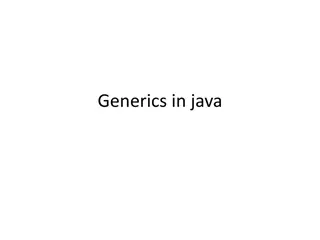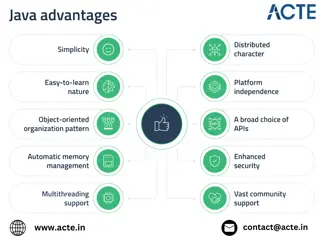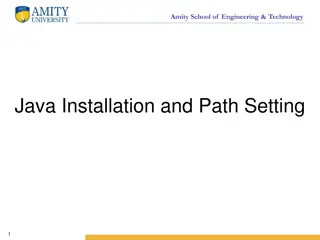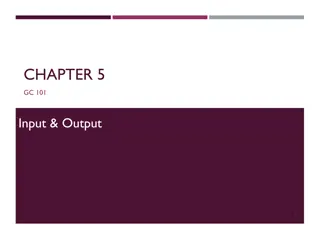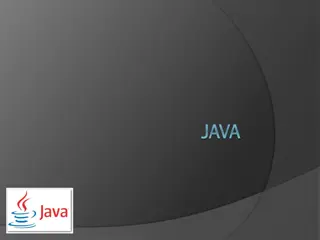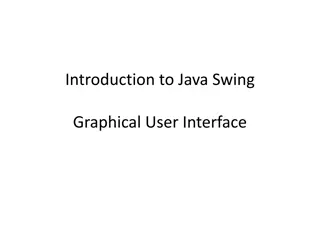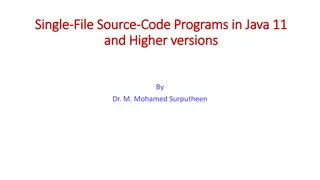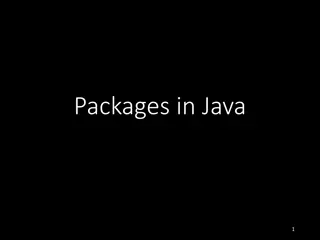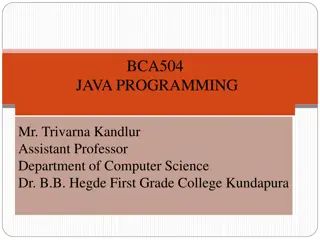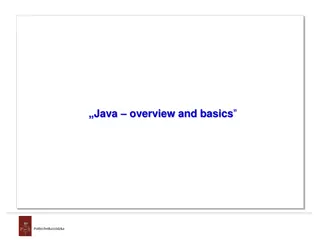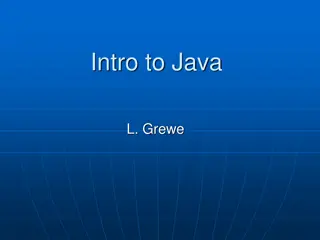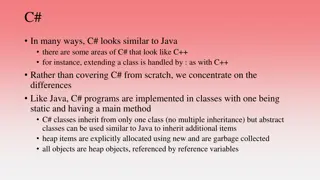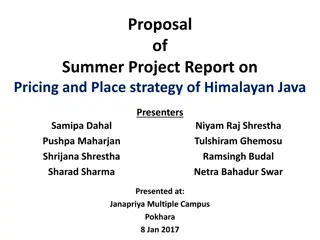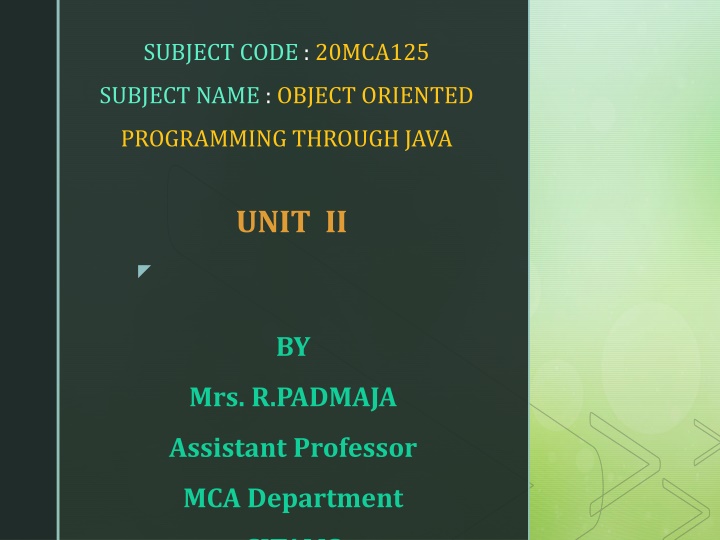
Object-Oriented Programming with Java: Inheritance, Packages, and More
Learn about inheritance, packages, classes, and methods in Java programming. Understand how to define classes, add variables and methods, create objects, and work with inheritance and packages. Explore the Java API, final variables, abstract methods, and visibility control.
Download Presentation

Please find below an Image/Link to download the presentation.
The content on the website is provided AS IS for your information and personal use only. It may not be sold, licensed, or shared on other websites without obtaining consent from the author. If you encounter any issues during the download, it is possible that the publisher has removed the file from their server.
You are allowed to download the files provided on this website for personal or commercial use, subject to the condition that they are used lawfully. All files are the property of their respective owners.
The content on the website is provided AS IS for your information and personal use only. It may not be sold, licensed, or shared on other websites without obtaining consent from the author.
E N D
Presentation Transcript
SUBJECT CODE : 20MCA125 SUBJECT NAME : OBJECT ORIENTED PROGRAMMING THROUGH JAVA UNIT II BY Mrs. R.PADMAJA Assistant Professor MCA Department SITAMS
Introduction UNIT II - INHERITANCE AND PACKAGES Defining a Class Adding Variables Adding Methods Creating Objects Accessing Class Members Constructors Method Overloading Static Members Inheritance Overriding Methods Final Variables, Methods and Classes Abstract Methods and Classes Visibility Control Introduction Java API Package Using System Package Naming Conventions. Creating Packages Accessing Package Packages
INTRODUCTION Java is a true object-oriented language and therefore the underlying structure of all java programs is classes. Classes provide a convenient method for packing together a group of logically related data data items items and functions functions that work on them. In Java, the data data items items are called fields fields and the functions functions are called methods methods.
2 Defining a Class A class is a user-defined data type with a template that serves to define its properties. Once the class type has been defined, we can create variables of that type using declarations that are similar to the basic type declarations. In Java, these variables are termed as instances of classes, which are the actual objects. Class Defines Data and Methods that manipulate the Data. The basic form of a class definition is class ClassName [extends SuperClassName] { } [fields declaration] [methods declaration] classname and superclassname are any valid java identifiers. The keyword extends indicates that the properties of the superclassname class are extended to the classname class.
3. Field Declaration Data is encapsulated in a class by placing data fields inside the body of the class definition. These variables are called instance variables because they are created whenever an object of the class is instantiated. We can declare the instance variables exactly the same way as we declare local variables class Rectangle { } int length; int width; The class Rectangle contains two integer type instance variables.It is allowed them in one line as int length, width; Remember these variables are only declared and therefore no storage space has been created in the memory. Instance variables are also known as member variables.
4. Methods Declaration A class with only data fields( and without methods that operate on that data) has no life. The objects created by such a class cannot respond to any messages. We must therefore add methods that are necessary for manipulating the data contained in the class. Methods are declared inside the body of the class but immediately after the declaration of instance variables. The General form of a method declaration is type methodName(parameter-list) { Method-body; }
Method declarations have four basic parts 1) The name of the method( methodname) 2) The type of the value the method returns(type) 3) A list of parameters(parameter-list) 4) The body of the method The type specifies the type of value the method would return. This could be a simple data type such as int or It could even be void type, if the method does not return any value. The methodnameis a valid identifier. The parameter list is always enclosed in parantheses. This list contains variable names and types of all the values we want to give to the method as input. The variables in the list are separated by commas. when no input data are required , the declaration must retain the empty parantheses.
The body actually describes the operations to be performed on the data. Class Rectangle { } int length,width; void getData(int x, int y) // method with void type { length =x; width =y; } int rectArea() { int area = length *width; return area; } // method with return type
Creating Objects Instance of a class is called an Object. 5. Creating an object is also referred to as instantiating an object. Objects in Java are created using the new operator. The new operator creates an object of the specified class and returns a reference to that object. Rectangle rect1; rect1 = new Rectangle() The first statement declares a variable to hold the object reference and // declare the object // instantiate the object The second one actually assigns the object reference to the variable. The variable rect1 is now an object of the Rectangle class Both statements can be combined into one as Rectangle rect1 = new Rectangle() It is important to understand that each object has its own copy of the instance variables of its class. Means that any changes to the variables of one object have no effect on the variables of another.
Rectangle rect1; // declare the object rect1 = new Rectangle() // instantiate the object
6. Accessing Class Members Fields and Methods inside the class are called Members of class. The Class members can be Accesses using objectName, dot operator and class member(may be variable or method). Objectname.variablename = value; Objectname.methodname(parameter-list) Here objectname is the name of the object, variablename is the name of the instance variable inside the object that we wish to access. methodname is the method that we wish to call, and parameter-listis comma separated list of actual values that must match in type and number with the parameter list of the methodname declaraed in the class.
Output Area1 = 150 Area2 = 240
The first approach is to access the instance variables using the dot operator and compute the area. i.e int areal = rect1.lenght*rectl.width: The second approach is to call the method rectArea declared inside the class. That is, int areal = rectl.rectArea(): // Calling the method
7. Constructors Java supports a special type of method called a constructor, that enables an object o initialize itself when created. Constructors are used to initialize instance variables. Constructor Method Constructor s are used to initialize instance variables Constructor Name and Class name should be same Constructor should have neither return type or void Constructors are invoked at the time of object creation Methods are used to do general purpose calculation Constructor name and Class name may or may not same Method should have either return type or void Methods are invoked after object is created.
output Area1 = 150
8. Methods Overloading In Java it is possible to define two or more methods within the same class that share the same name, as long as their parameter declarations are different. (or) writing two or more methods within Same class with difference in type and/or number of arguments. When this is the case, the methods are said to be overloaded, and the process is referred to as method overloading. Method overloading is one of the ways that Java supports polymorphism. When an overloaded method is invoked, Java uses the type and/or number of arguments as its guide to determine which version of the overloaded method to actually call. Thus, overloaded methods must differ in the type and/or number of their parameters.
class Addition { } class MethodOverloading { public static void main(String args[]) { Addition obj1 = new Addition(); int add2 = obj1.add(2,3); int add3 = obj1.add(3,4,5); double add2d = obj1.add(2.4,3.5); System.out.println( Addition of 2 integer values: +add2); System.out.println( Addition of 3 integer values : +add3); System.out.println( Addition of 2 double values : +add2d); } } int add(int x, int y) { } int add(int x, int y,int z) { } double add(double x, double y) { double z = x+y; Return z; } int z = x+y; Return z; int a = x+y+z; Return a; OUTPUT: Addition of 2 integer values: 5 Addition of 3 integer values : 12 Addition of 2 double values:5.9
add is the only interface through which we are getting 3 types of output i.e addition of 2 integer values, addition of 3 integer values and addition of 2 double values. When we call a method in an object, java matches up the method name first and then the number and type of parameters to decide which one of the definitions to execute. This process is known as polymorphism
Static Members Class or Static Methods Instance Methods Class Methods are declared with keyword static Static Methods are associated to the class in which they reside i.e they can be called even without creating an instance of the class. Instance Methods are declared without static keyword Instance Method are methods which require an object of its class to be created before it can be called Static methods cannot be overridden Instance methods can be overriden Instance Method can access the instance methods and instance variables directly Instance method can access static variables and static methods directly Static methods can access the static variables and static methods directly Static methods cant access instance methods and instance variables directly. They must use reference to object. And static method cant use this keyword as there is no instance for this to refer to.
10. Inheritance Reusability is an important concept of OOP paradigm. It is always nice if we could reuse something that already exists rather than creating the same all over again. Java supports this concept. Java classes can be reused in several ways. This is basically done by creating new classes, reusing the properties of existing ones. The mechanism of deriving a new class from an old class such that the new class acquires all the properties of the old class is called Inheritance. The old class is known as Parent, base or Super class and the new class that is derived is known as child, derived or subclass. The Inheritance allows subclasses to inherit all the variables and methods of their parent classes.
Defining a Subclass A Subclass is defined as follows Class subclassname extends superclassname { Variables declaration Methods declaration } The keyword extends signifies that the properties of the superclassname are extended subclassname. The subclass will now contain its own variables and methods as well those superclass. This kind of situation occurs when we want to add some more properties to an existing class without actually modifying it. Subclass Constructor A subclass constructor is used to construct the instance variables of both the subclass and the superclass. The subclass constructor uses the keyword super to invoke the constructor method of the superclass.
The keyword super is used subject to the following conditions Super may only be used within a subclass constructor method The call to super class constructor must appear as the first statement within the subclass constructor. The parameter in the super call must match the order and type of the instance variable declared in the super class
Inheritance may take different types 1) Single inheritance 2) Multilevel Inheritance 3) Hierarchical Inheritance 4) Hybrid Inheritance 5) Multiple Inheritance


